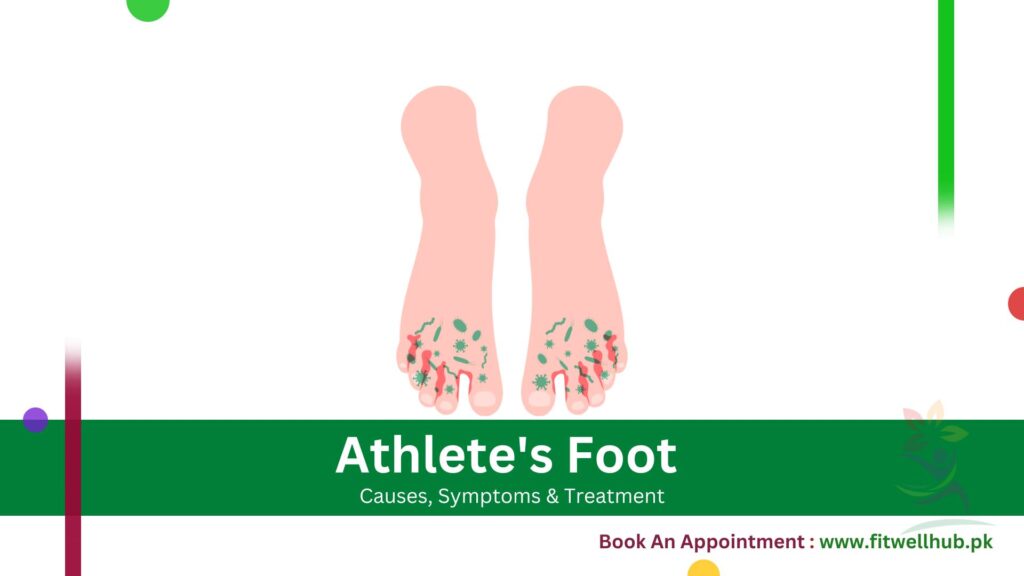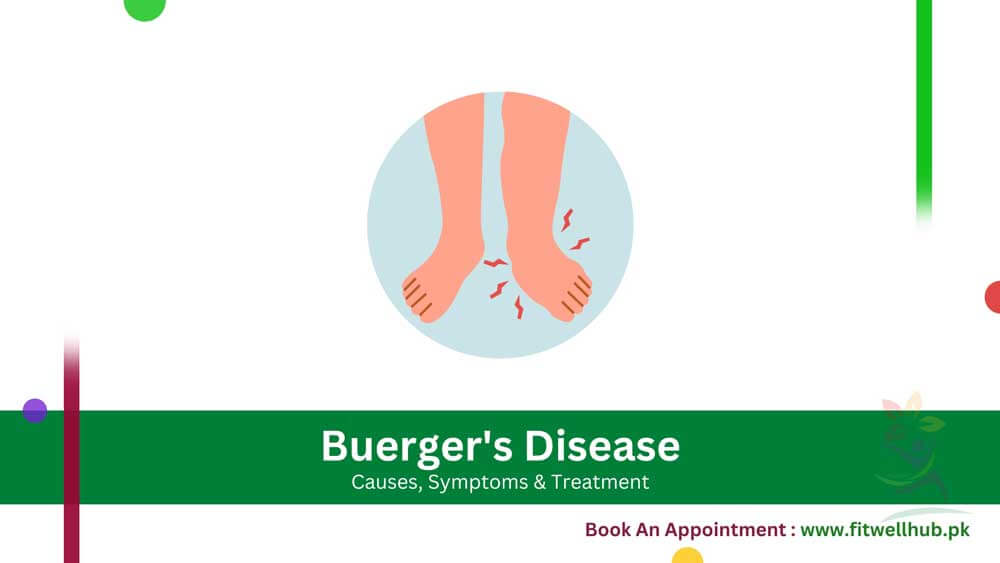Athlete’s foot is a general fungal infection also referred to as tinea pedis. It mainly affects the skin on the feet, especially between the toes. This infection occurs due to dermatophytes, fungi that develop in moist and warm environments. Communal areas like swimming pools, locker rooms, and public showers are ideal locations where individuals can contract the infection. It can spread to other body parts, such as the hands and toenails, if not treated or managed properly.
Quick Links
ToggleAlthough athlete’s foot is generally not a serious medical problem, it can be hard to eliminate and frequently occur again, particularly in people who often expose their feet to enclosed, damp environments. The infectious disease can be transmitted by touching contaminated surfaces or coming into contact with infected individuals. Wearing protective footwear in communal places, maintaining good hygiene, and managing early symptoms of Athlete’s Foot are crucial preventive measures to manage infection. The integration of AI in healthcare has revolutionized early detection and management strategies for fungal infections like athlete’s foot.
Symptoms of Athlete’s Foot
The symptoms of Athlete’s Foot can vary from mild to serious or fatal and usually begin with painful, burning, or peeling skin on the foot, particularly between the toes. Common symptoms involve:
- Itching and burning are the most significant symptoms of infection, particularly in the area between the toes. This frequently occurs as the fungal infection develops skin irritation, causing discomfort and inflammation.
- Dry, peeling skin: With the infection progression, it usually makes the feet’s skin dry, the soles, and start peeling. This peeling appears as flakes or patches on the skin and can worsen if left untreated.
- Blisters: This fungal infection can lead to small blisters on the feet that are filled with fluid, burst, and then form a hard layer, causing discomfort and raising the chances of infection progression.
- Cracked, raw skin: Raw and cracked skin can result from this infection, especially in body parts that are more exposed to moisture, like between the toes. This condition can lead to painful walking and raise the chances of developing secondary bacterial infections.
- Discolored or thickened toenails: If this infection expands to the toenails, they can become brittle, discolored, and thickened. This fungal nail infection, also named onychomycosis, can result in long-term nail damage if not treated on time.
- Foul odor: A significant foul odor may occur due to this infection, particularly in severe cases, or persist for some time without any treatment.
- Scaling and redness: Feet skin can become scaly and red with the infection progression. This scaling and redness can be localized in particular areas like between the toes or impact the entire foot.
When to See a Doctor
You must seek medical care if symptoms of athlete’s foot worsen and don’t improve with over-the-counter medications. Severe and chronic infections may need stronger prescription medications or further medical intervention. Infections can grow more quickly and become more severe in individuals with weak immune systems or diabetes, so they must contact a doctor at the very first symptom.
Moreover, suppose you experience open sores, blisters, or infection progression to the hands or toenails. In that case, it is important to consult a doctor, as untreated athlete’s foot can cause complications like secondary bacterial infections. FitwellHub provides complete medical assistance such as consultations with experienced podiatrists and dermatologists, specialized in treating skin infections including athlete’s foot. To book an appointment, visit our FitwellHub.
Causes
Athlete’s foot is caused by dermatophyte fungi, which thrive in warm, damp environments. The fungi that cause this infection can be found on floors, towels, and clothing in communal areas. Common causes of athlete’s foot include:
1- Walking barefoot in public places
Public showers, locker rooms, and swimming pools are common breeding grounds for the fungi that cause athlete’s foot. Walking barefoot in these areas increases the risk of contracting the infection.
2- Wearing tight, enclosed shoes
Tight shoes can trap heat and moisture, creating the perfect location for fungi to develop. People who wear close, tight shoes for long periods are at a greater risk of infection development.
3- Sharing personal items
Sharing shoes, socks, or towels with others diagnosed with athlete’s foot may spread the fungal infection. The fungi can thrive on such surfaces and easily spread to other people.
4- Keeping feet wet for extended periods
Fungi thrive in damp conditions, so keeping your feet wet for prolonged periods, whether from sweating or not drying your feet properly, can increase your chances of infection.
5- Not drying feet properly
After bathing or swimming, not drying your feet thoroughly, particularly between the toes, can leave moisture trapped, which encourages fungal growth.
6- Sweating excessively
Sweaty feet create a moist environment that promotes the growth of the fungi that cause athlete’s feet. Excessive sweating, especially in tight shoes, can exacerbate the condition.
7- Wearing non-breathable socks or shoes
Non-breathable materials trap moisture and heat, making it easier for fungi to grow on the skin of the feet.
8- Cultural practices
In Pakistan, communal ablution spaces in mosques and shared showers can increase exposure to fungal infections if proper hygiene is not maintained.
Risk Factors
Specific risk factors that can increase the chances of athlete’s foot development are:
- Living in warm, humid climates: These environments are suitable for fungal development. People living in these places are more prone to developing infections.
- Weakened immune system: Individuals with weak immune systems, whether due to medications or diseases, are more susceptible to developing athlete’s foot.
- Having diabetes: Diabetes can lessen the blood flow to the feet. It reduces the body’s ability to fight against infections, leading to an easier athlete’s foot development and progression.
- Poor foot hygiene: Neglecting to clean and dry the feet completely, particularly after physical activity, raises the chances of developing the athlete’s foot.
Complications
Although this condition is typically a mild infection, complications can occur if left untreated or managed improperly. These complications may involve:
1- Secondary bacterial infections
An athlete’s foot can cause abrasions (breaks in the skin), which can cause secondary bacterial infections. These infections need antibiotics and can lead to more severe conditions if not treated early.
2- Fungal infections in other areas
If the fungi causing athlete’s foot spread, it can lead to infections in other parts of the body, such as the hands (tinea manuum) or the groin (tinea cruris, also known as jock itch).
3- Onychomycosis (nail infections)
Fungal infections can spread to the toenails, causing them to become thickened, discolored, and brittle. Nail infections are more difficult to treat and may require oral antifungal medications.
4- Chronic recurrence
Athlete’s foot often recurs, especially if the underlying conditions that caused the infection, such as excess moisture or tight footwear, are not addressed.
5- Higher cellulitis risks
In severe cases, an athlete’s foot can increase the risk of cellulitis, a bacterial infection of the skin that can become life-threatening if not treated promptly.
6- Chronic recurrence
Athlete’s foot often returns if proper care isn’t taken to manage the fungal infection and the conditions that promote it, such as excess moisture. Modern healthcare technology helps manage and minimize these complications effectively.
Prevention
Some of the effective methods to prevent athlete’s foot are:
1- Wear breathable shoes
Choose shoes manufactured with breathable materials like mesh or leather that decrease the buildup of moisture and allow better air passing.
2- Change socks regularly
Regularly change your socks, particularly after sweating or physical activity. Wear clean and dry socks to prevent the fungi growth.
3- Avoid walking barefoot in public places
Wear flip-flops or sandals in communal places such as swimming pools, showers, and locker rooms to prevent direct contact with infected surfaces.
4- Keep feet dry
Dry your feet completely, particularly between the toes, after swimming or bathing. Moisture between the toes is an ideal spot for fungal growth.
5- Use antifungal powders
Apply antifungal powder inside your shoes and on your feet to minimize the moisture and avoid fungal infections from taking hold.
6- Disinfect shoes
Disinfect your shoes regularly to kill any fungi that may be growing inside them and prevent infection recurrence.
Smart Hospital offers a specialized program focused on preventing infections, including athlete’s foot, by promoting proper hygiene and lifestyle practices.
Diagnosis
Diagnosing an athlete’s foot generally involves a physical assessment of the impacted area, symptoms, and activities. In some cases, further tests are also needed to confirm the diagnosis.
Tests
- Skin scraping test: In this test, a doctor scrapes a little sample of impacted skin and examines it with a microscope to detect the existence of fungi.
- Wood’s lamp test: This test helps to identify specific forms of fungi on the skin by using a particular light.
- Fungal culture: A skin sample might be sent to a laboratory to grow the fungi and identify the exact kind of infection.
- KOH (Potassium hydroxide) test: The affected skin sample is placed into a KOH solution, which helps to identify the presence of fungi using a microscope.
FitwellHub provides lab services for comprehensive diagnostic tests for fungal infections such as athlete’s foot. To schedule a test, visit our lab.
Treatment
The objective of treating athlete’s foot is to get rid of the fungal infection and stop it from coming back. Common treatment options involve:
1- Topical antifungal creams
Prescription or over-the-counter antifungal creams, including terbinafine or clotrimazole, are generally used for treating infections and applied on the affected area directly to remove the fungi and alleviate symptoms.
2- Oral antifungal medications
A doctor may recommend oral antifungal medications like fluconazole or itraconazole to treat the infection from within the body in more severe cases.
3- Antifungal powders and sprays
These medications are applied on the feet and inside shoes to prevent the buildup of moisture and eliminate the fungi that can cause infection.
4- Home remedies
Some people find relief from mild athlete’s foot symptoms by using home remedies, such as soaking their feet in diluted vinegar or using tea tree oil, which has antifungal properties.
Medications
Medications used for treating athlete’s foot usually involve prescription or over-the-counter antifungals. Some commonly suggested medications involve:
1- Clotrimazole (Lotrimin)
It is a common over-the-counter antifungal cream that relieves itching and removes the fungal infection and is generally applied to the impacted area twice a day.
2- Terbinafine (Lamisil)
Terbinafine is another oral or topical antifungal medication and is frequently prescribed for challenging cases, as it stops the fungus from growing.
3- Miconazole (Micatin)
Miconazole is available in creams and sprays and helps damage the cell walls of the fungi, ultimately killing the infection.
4- Itraconazole (Sporanox)
Itraconazole is an oral antifungal medication prescribed for more severe cases of athlete’s foot or when the infection spreads to the toenails.
5- Fluconazole (Diflucan)
Fluconazole is an oral antifungal medication that may be used for persistent cases of athlete’s foot or when the infection does not respond to topical treatments.
FitwellHub integrates advanced telemedicine solutions for remote consultations and prescription management, ensuring quality care at your convenience. We provide a range of medications, including those used to treat athlete’s foot. To place an order, visit our pharmacy.
Conclusion
Athlete’s foot, or tinea pedis, is a common fungal infection caused by dermatophyte fungi thriving in damp, warm environments. Key symptoms of athlete’s foot include itching, peeling skin, blisters, and thickened toenails. The causes of athlete’s foot often involve poor foot hygiene, tight footwear, or exposure to shared public spaces like pools or locker rooms.
Preventive measures, such as keeping feet clean and dry, wearing breathable shoes, and using antifungal products, can help reduce the risk. Early treatment is essential to avoid complications. FitwellHub offers expert care and telemedicine services for effective management and recovery.
Frequently Ask Questions (FAQ’s)
Mostly, athlete’s foot is caused by dermatophyte fungi, which thrive in warm, moist conditions like public showers or locker rooms.
Topical antifungal creams like terbinafine or clotrimazole are highly effective; severe cases may require oral antifungals prescribed by a doctor.
With proper treatment using antifungal creams and maintaining good hygiene, mild cases can improve within 1–2 weeks, but severe cases may take longer.
Fungus is a general group of organisms, but athlete’s foot is a specific fungal infection resulting from dermatophytes and affects the skin on the feet.
No particular deficiency results in an athlete’s foot, but a weakened immune system due to poor nutrition or illness can increase risk.
While usually mild, untreated athlete’s foot can lead to secondary bacterial infections, nail infections, or chronic recurrence, requiring medical attention.











